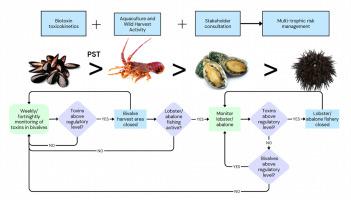Multi-trophic paralytic shellfish toxin risk and management across seafood sectors in Tasmania
IF 4.5
1区 生物学
Q1 MARINE & FRESHWATER BIOLOGY
引用次数: 0
Abstract
Multi-trophic biotoxin risk management is critically important to regions that suffer from extensive blooms of paralytic shellfish toxin (PST) producing algae. In Australia, Tasmania’s east and south-east coasts are hotspots for PST activity due to recurrent blooms of Alexandrium catenella and Gymnodinium catenatum occurring in differing geographic regions and seasonal patterns. Toxins have been measured above bivalve regulatory levels in filter feeders, predatory crustaceans and herbivorous grazers at maximum levels of 340, 13.6 and 3.0 mg STX.2HCl equiv. kg-1 respectively, affecting commercial and recreational fisheries with a combined annual value of USD 103M. Toxin accumulation and depuration rates are highest in bivalve shellfish, followed by lobster and then abalone. Managing PST risk across these multiple seafood species in an area of recurrent bloom activity is challenging. Currently a siloed approach is taken, with diverse strategies for each species that reflect the harmful algal bloom dynamics and varied fishing activities. This review of Tasmanian data and the following stakeholder consultation identified benefits to adopting an integrated approach to risk management across all seafood species. Benefits included cost efficiencies (USD 54,100 per annum), improved data sharing for real-time awareness, streamlined communication and improved cross-sector collaboration.

塔斯马尼亚州海产品部门的多营养麻痹性贝类毒素风险和管理
多营养生物毒素风险管理对于遭受麻痹性贝类毒素(PST)产生藻类大量繁殖的地区至关重要。在澳大利亚,塔斯马尼亚州的东部和东南部海岸是PST活动的热点,因为在不同的地理区域和季节模式下,经常出现亚历山大菌和链状裸子菌的大量繁殖。在滤食性动物、掠食性甲壳类动物和食草动物中测得的毒素高于双壳类动物的规定水平,最高水平分别为340、13.6和3.0 mg STX.2HCl当量公斤-1,影响商业和休闲渔业,年总价值达1.03亿美元。双壳贝类的毒素积累和净化率最高,其次是龙虾,然后是鲍鱼。在一个反复爆发活动的地区,管理这些多种海产品的PST风险是具有挑战性的。目前采取的是孤立的方法,对每个物种采取不同的策略,以反映有害藻华的动态和不同的捕捞活动。对塔斯马尼亚数据的审查和随后的利益相关者咨询确定了对所有海产品品种采取综合风险管理方法的好处。收益包括成本效率(每年54,100美元)、改善实时感知的数据共享、简化沟通和改善跨部门协作。
本文章由计算机程序翻译,如有差异,请以英文原文为准。
求助全文
约1分钟内获得全文
求助全文
来源期刊

Harmful Algae
生物-海洋与淡水生物学
CiteScore
12.50
自引率
15.20%
发文量
122
审稿时长
7.5 months
期刊介绍:
This journal provides a forum to promote knowledge of harmful microalgae and macroalgae, including cyanobacteria, as well as monitoring, management and control of these organisms.
 求助内容:
求助内容: 应助结果提醒方式:
应助结果提醒方式:


